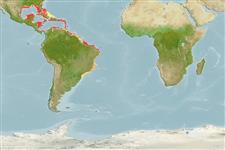>
Eupercaria/misc (Various families in series Eupercaria) >
Scaridae (Parrotfishes) > Sparisomatinae
Etymology: Cryptotomus: Greek, kryptos = hidden + Greek, tomos, = section, cut (Ref. 45335).
More on author: Cope.
Environment: milieu / climate zone / depth range / distribution range
Ecología
marino asociado a arrecife; rango de profundidad ? - 60 m (Ref. 13628). Tropical; 32°N - 33°S
Western Atlantic: Bermuda, southern Florida (USA), and Bahamas to Brazil (Ref. 7251). Possibly in Ascension I. (Ref. 98447).
Tamaño / Peso / Age
Maturity: Lm ? range ? - ? cm
Max length : 13.0 cm TL macho / no sexado; (Ref. 7251); common length : 10.0 cm TL macho / no sexado; (Ref. 5217)
Espinas dorsales (total): 9; Radios blandos dorsales (total): 10; Espinas anales 2; Radios blandos anales: 9. Jaw teeth fused only at bases. Anterior nostril without membranous flap (Ref. 26938). Male color, olivaceous on the back with small pink dots; a salmon stripe along the side with a row of green dots; body below stripe light green with some salmon markings on scales (Ref. 13442).
Inhabits seagrass beds and weedy areas with sand (Ref. 9710). Feeds on seagrasses (Ref. 9710). Buries in the sand to sleep in a mucus tube (Ref. 9710). Protogynous hermaphrodite (Ref. 55367).
Life cycle and mating behavior
Madurez | Reproducción | Puesta | Huevos | Fecundidad | Larva
Forms leks during breeding (Ref. 55367). A monandric species (Ref. 55367). Length at sex change = 5.75 cm TL (Ref. 55367).
Robins, C.R. and G.C. Ray, 1986. A field guide to Atlantic coast fishes of North America. Houghton Mifflin Company, Boston, U.S.A. 354 p. (Ref. 7251)
IUCN Red List Status (Ref. 130435)
Threat to humans
Harmless
Human uses
Acuario: Comercial
Más información
ReferenciasAcuiculturaPerfil de acuiculturaRazasGenéticaElectrophoresesheritabilidadEnfermedadesProcesamientoNutrientsMass conversion
ColaboradoresImágenesStamps, Coins Misc.SonidosCiguateraVelocidadTipo de nataciónSuperficie branquialOtolitosCerebrosVisión
Herramientas
Special reports
Download XML
Fuentes de Internet
Estimates based on models
Preferred temperature (Ref.
123201): 24.4 - 28, mean 26.9 °C (based on 316 cells).
Phylogenetic diversity index (Ref.
82804): PD
50 = 1.0000 [Uniqueness, from 0.5 = low to 2.0 = high].
Bayesian length-weight: a=0.01096 (0.00683 - 0.01761), b=3.16 (3.02 - 3.30), in cm total length, based on LWR estimates for this species & (Sub)family-body (Ref.
93245).
Nivel trófico (Ref.
69278): 2.0 ±0.00 se; based on food items.
Resiliencia (Ref.
120179): Alto, población duplicada en un tiempo mínimo inferior a 15 meses (Preliminary K or Fecundity.).
Fishing Vulnerability (Ref.
59153): Low vulnerability (10 of 100).
Nutrients (Ref.
124155): Calcium = 117 [65, 245] mg/100g; Iron = 1.11 [0.58, 1.89] mg/100g; Protein = 18.3 [16.3, 20.1] %; Omega3 = 0.129 [0.071, 0.230] g/100g; Selenium = 39.1 [20.2, 77.6] μg/100g; VitaminA = 54 [16, 189] μg/100g; Zinc = 2.57 [1.69, 4.08] mg/100g (wet weight);
